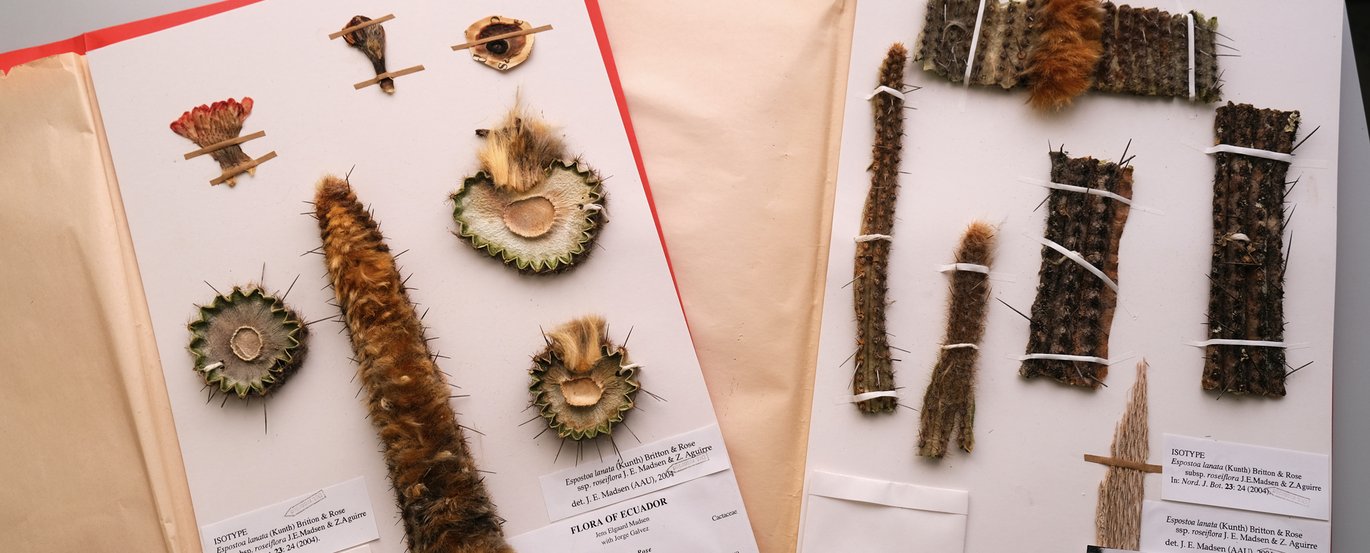The herbarium at Aarhus University houses 750,000 plants from all over the world, spread across three floors – and new specimens are added each week
In the herbarium at Aarhus University, plant history is guaranteed for future generations. Neatly archived in folders and glass jars, up to 750,000 different collections of plants are stored on shelves which are spread over three floors. The collection is used by researchers from all over the world.

At the University Park campus, the university stores up to 750,000 compressed, dried plants. They are stored in so-called herbarium sheets and cover nine kilometres of shelf space.
The three-story yellow-brick building is the herbarium at Aarhus University, which is “a collection of compressed, dried plants for scientific study”, according to biologist and administrator of the herbarium.
Birgitte Bergmann coordinates a group of four members of staff, whose duties include looking after the collection, being in charge of depositing and loaning collections at the herbarium and ensuring that new plant specimens are archived correctly.
This is a place for researchers, who come from all over the world to look through the plant archive at Aarhus University. When of course the world isn’t in lockdown due to a global pandemic.
”It’s very quiet right now,” explained Birgitte Bergmann.
While the Covid-19 pandemic is stopping researchers from visiting the herbarium, new plant specimens continue to arrive from all corners of the world.
They are most often collected by researchers, who have documented the plant’s history in great detail, including the date it was found, the altitude at which it was found, specific coordinates for where it was found, a description of the area where it was found, the appearance of the plant, and who found the plant.
Birgitte Bergmann and her team catalogue the plants and present them neatly similar to a Flora Danica style on white sheets of paper and categorise them so that they can be found again.

A more than 250-year-old plant found in Harzen, Germany. Photo: Omnibus/Nicklas Larsen
Private collections are inherited
Now and again, the herbarium also receives collections from private Danish herbaria, which are often run by people as a hobby:
”In the middle of the 18th Century, a hebarium was a symbol of status, and well-to-do princes had herbaria. The aim was to have a collection of all known types of plants,” explained Birgitte Bergmann.
However, the collections that they receive today often come from former students:
”In the 1940s, 50s and 60s, students from several educational programmes collected dried plants. Some were really taken by this and therefore since then they have nurtured their collections. When they decide one day that they want to give away their private herbarium collections, we would be very open to receiving the parts that we need for our collection.”

There is no public access to the herbarium, situated near the University Park. Photo: Omnibus/Nicklas Larsen
The future of the herbarium
The collection is continuously being digitalised, often inspired by which plants the researchers ask to look at. But this is a process which will take time:
”A little over 154,000 of our plants are now digitalised to some degree and are available via our online database,” said Birgitte Bergmann.
More recently the DNA of the plants is being registered, which gives a new understanding of the plant family:
”It’s quite a challenge when we receive completely new data on plants. We can’t simply just update the names of the plants, but we also have to relocate them within the herbarium. This means that our method of archiving is being challenged,” said Birgitte Bergmann.
Handling and storing the plants with care
The herbarium at Aarhus University works closely with several other herbaria around the world, who have come together to help each other with expanding the collections. Therefore, it’s possible that duplicates of the plants at AU can be found at other herbaria and vice versa.
There are strict safety rules in relation to the storage of the plants. When a plant first arrives at the herbarium, it has to be stored at -36 degrees Celsius in a freezer for eight days to ensure that any insects on the plant are dead and that they can’t invade and destroy the collection.
The plants are stored at around 20 degrees Celsius and at a humidity of around 40 per cent. Sheets which contain plants of the same species are stored together in a cover, which also helps to keep the plants away from sunlight. And the building is surrounded by an extra layer of concrete to protect the collections against water and the underground stream that runs through the University Park.
Certain parts of the plants which cannot be stored in the herbarium are archived in boxes or in certain cases in glass jars filled with 70 per cent ethanol to ensure that they are preserved correctly.

Photo: Omnibus/Nicklas Larsen

Photo: Omnibus/Nicklas Larsen
Translated by Marian Flanagan

